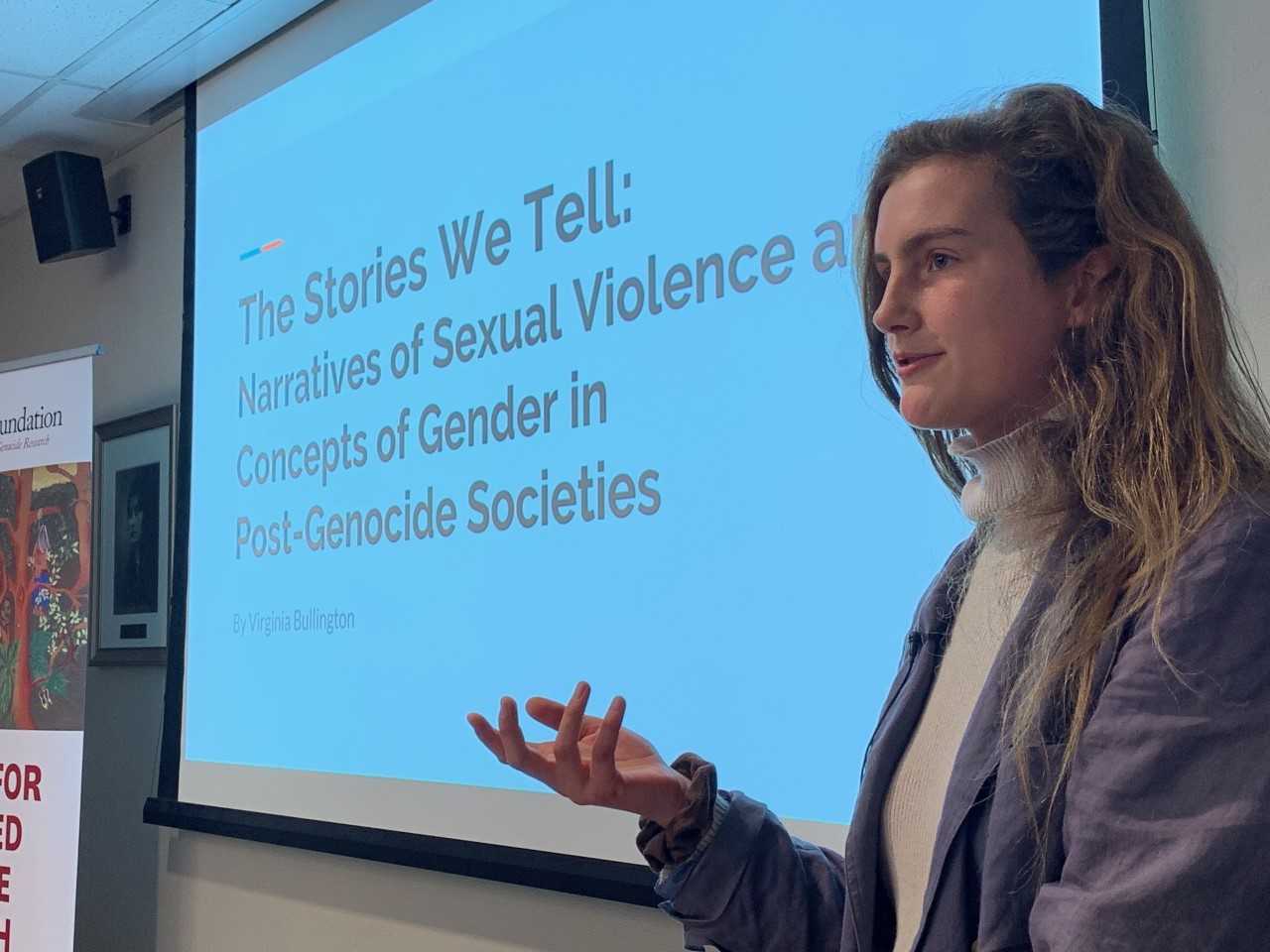Virginia Bullington lectures about discussions of sexual violence in female survivor testimonies

“The Stories We Tell: Narratives of Sexual Violence and Concepts of Gender in Post-Genocide Societies”
Virginia Bullington (USC undergraduate, Narrative Studies)
2018 Beth and Arthur Lev Student Research Fellow
January 23, 2019
Virginia Bullington, the 2018 inaugural Beth and Arthur Lev Student Research Fellow, gave a public lecture on the research she conducted during her month in residence at the Center for Advanced Genocide Research. During her residency, Bullington explored the testimonies of female survivors of the Armenian, Rwandan, and Guatemalan genocides housed in the USC Shoah Foundation Visual History Archive (VHA) to examine the ways that the discussions of sexual violence in testimony reflect concepts of gender within post-conflict societies.
Bullington opened her lecture by reminiscing on her unexpected journey into the research of sexual violence in genocide, and the process of formulating her research question. Recalling her being alarmed by the ubiquity of sexual violence in genocide, she emphasized the timeliness of her topic, especially considering the frequency of sexual abuse cases today.
After detailing her learning about the Armenian, Rwandan, and Guatemalan genocides, Bullington turned to some similarities and differences between the three genocides, especially when it comes to their causes, post-genocide transitional justice processes, and the contemporary remembrance of these atrocities. For example, by drawing from the existing scholarly work on these genocides, Bullington learned that all three genocides took place amidst increased ethnic divisions and tensions, and that all three took place in countries ruled by corrupt, unstable governments. On the other hand, she realized that while Rwanda is seen as a successful example of post-genocide transitional justice, the Turkish government denies the Armenian genocide, and the conviction of Guatemalan genocide perpetrators is still slow and ineffective.
Bullington then addressed the methodology she used for working with the Visual History Archive testimonies. She explained how she selected those testimonies that mentioned sexual violence, assault, or gender roles. She analyzed the rhetorical techniques employed by the survivors to discuss sexual violence, the content and the duration of their discussion of it, and the survivors’ emotional and non-verbal responses to their recollection of past trauma. In addition, she paid attention to the context in which the interview was given.
Taking all of these factors into account, Bullington reflected on the ways that the Armenian, Rwandan, and Guatemalan survivors of genocide discuss sexual violence. For example, she noted that the Armenian survivors are very upfront about and descriptive of sexual violence suffered by both themselves and others. Bullington noted that Armenian women being considered symbols of Armenian nation affected the way sexual violence is discussed in testimony, as it is seen as shameful. In Rwandan testimonies, on the other hand, women often countered their frequent portrayal as helpless victims of sexual violence, and they consciously disclosed the names of every female victim that they know of, giving these victims agency. They also discussed instances of cunning, individuality, and competence, complicating the notion of them as only victims. Finally, when it comes to Guatemalan testimonies, Bullington pointed to the explicit language used to describe sexual violence, and survivors’ use of testimony as a form of bearing witness, especially considering the status of indigenous women in contemporary Guatemalan society.
Bullington argued that the ways sexual violence was employed during the three genocides in question were conditioned by the function of women in these respective societies. She noted that, thanks to her research with testimonies, she learned not only that the ways people tell their stories of the past are influenced by the present, but also that the ways others listen to those stories affect whether and how they are told.
In the final part of her lecture, Bullington discussed how her research with testimonies has made a significant impact on her evolution as a scholar and on her studies, especially on her project for an Asian American Literature class, in which she examined the role of the female voice in constructing memory in the aftermath of the Nanjing Massacre. In addition, her research at the Center inspired the idea for her capstone project, in which she hopes to study women’s roles in constructing narratives.
Bullington’s lecture was followed by a lively Q&A session, which addressed the question of women as vessels of nationalism in the Armenian genocide; the use of euphemisms in testimonies to describe rape; Japanese denial of the Nanjing massacre and the danger of post-genocide narratives becoming a form of nationalism damaging to survivors; differences in processing trauma by differing groups of women; the impact of temporal distance on survivors’ narratives; the impact of Bullington’s personal experience on her approach to testimonies; and the possibility of familiarizing survivors with the existing narratives about specific genocides and their impact on survivors’ individual trauma.
Summary by Badema Pitic.
________________________________________
The Stories We Tell: Narratives of Sexual Violence and Concepts of Gender in Post-Genocide Societies
In this lecture, 2018 Beth and Arthur Lev Student Research Fellow Virginia Bullington will reflect on research she conducted last summer at the USC Shoah Foundation Center for Advanced Genocide Research analyzing how testimonies from the Armenian, Guatemalan and Rwandan genocides regarding sexual violence are constructed by interviewees, and how these narratives influence and are influenced by contemporary concepts of gender in those societies post-conflict.